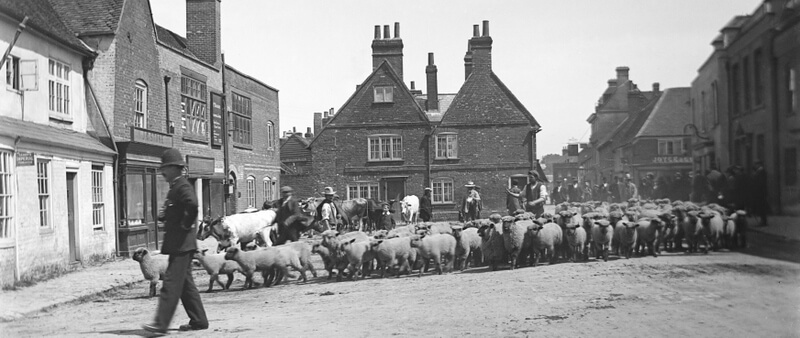A large part of the building on the North side of Market Square was built in the 15th century and was at first St Katherine’s Fraternity, later known as Church House. (Click here for an article which includes an artist’s impression of the building). The first Workhouse was part of this building in the early 1600s for ‘the poor to work in linen’. It was originally thatched and with an open lower floor meeting place before the Market Hall was built. (See the article below about the history of Church House.)
 Dr Challoner’s Grammar School was founded here in 1624 by the then Rector. However by 1662, a Bishop’s report said “We have a free grammar school founded by Dr Challoner, late Rector the Church of Amersham, and £20 per annum for ever by decree in Chancery and is no way ordered or governed as it ought to be nor the revenues thereof employed according to the intentions of the founder, nor of such grants and ordinances as have been made concerning the same”.
Dr Challoner’s Grammar School was founded here in 1624 by the then Rector. However by 1662, a Bishop’s report said “We have a free grammar school founded by Dr Challoner, late Rector the Church of Amersham, and £20 per annum for ever by decree in Chancery and is no way ordered or governed as it ought to be nor the revenues thereof employed according to the intentions of the founder, nor of such grants and ordinances as have been made concerning the same”.
The school stayed there nearly 300 years until 1902 when it moved to the present site at Amersham-on-the-Hill. It was bought in 1902 by Mr C M Cheese for £250. A fire during the night of Sunday 15th June 2008 destroyed a large part of this building, which has now been restored.
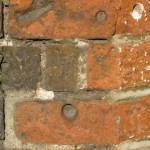
 If you look at the bricks on either side of the door outside the site of the original Dr. Challoner’s school, you will see a number of conical dark holes in the brickwork (photo on the right). These are believed to be created by boys sharpening their slate pencils before going into schools. Children often had to bring a dampened cloth or sponge to school so that they could clean their slates and start again and this is the origin of the phrase ‘to wipe the slate clean’. The photo above shows that boys used to carve their names on their desks nearly four hundred years ago! If you look carefully, you can see the name ‘Child’, a well known family name in Amersham’s history, many of them involved in brewing or as publicans.
If you look at the bricks on either side of the door outside the site of the original Dr. Challoner’s school, you will see a number of conical dark holes in the brickwork (photo on the right). These are believed to be created by boys sharpening their slate pencils before going into schools. Children often had to bring a dampened cloth or sponge to school so that they could clean their slates and start again and this is the origin of the phrase ‘to wipe the slate clean’. The photo above shows that boys used to carve their names on their desks nearly four hundred years ago! If you look carefully, you can see the name ‘Child’, a well known family name in Amersham’s history, many of them involved in brewing or as publicans.
Listen to Jean Archer talking in 1991 about where Dr Challoner’s school started
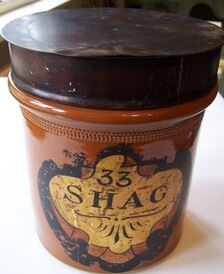
No. 13 on the corner of Church Street was a workhouse in 1739. By 1851 , Francis Rogers, an ironmonger, lived here. In the 1891 and 1901 censuses it is the Conservative Club. From 1907 to 1931 it was a hairdresser and tobacconist run by Ernest Wilson and later by Mrs Hilda Wilson. By 1952 the shop was known as Butler’s and sold toys, and the collection of dinky toys held by Amersham Museum was bought there.
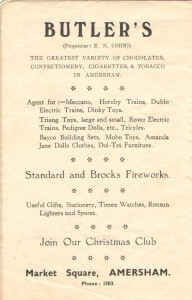
Mr. Corns, who was one of the founders of Amersham Museum, then ran the shop with his wife Marie.
No. 11 – for many years this was either a café or restaurant. It was run for many years by Mrs. Paget (whose husband ran The Malt House) and was know as The Inn Cafe. It has changed hands a number of times and for a while was known as The Brief Encounter and then Paupers.
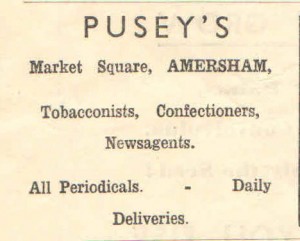
No. 7 – in the 1930s these premises were a butchers shop by the name of Puseys, brother to Maggie Pusey who owned the Newsagents next door. Mr. Pusey later moved his butcher’s business across the road to a butcher’s business by the name of Bedford. The shop then became a Wool and baby Linen shop owned by Mrs. Howell who had moved from across the road in part of what is now the Crown Hotel. Upon retiring, Mrs. Howell sold out to Mrs. Leigh who carried on in the same kind of business until she retired and sold out to Miss Tomlin, who also carried on in the same kind of trade. When Miss Tomlin moved to a shop in The Broadway, the shop changed trades and was known as Bethan Galleries and was owned by Mrs. Stevens, who had a large display of pictures and artists’ materials. When Mrs. Stevens sold up the premises were divided into 2 shops – one was known as Narcissus and the other a Wine Shop. In 1985 Narcissus sold up and was then known as Arabella.
No. 1 – this was the Willow Tree Café and has seen many different owners, all of whom have made changes in layout. Miss Cook owned it for many years also a Mr. & Mrs. Madour, Mr. & Mrs. Gamblin and Mark & Carol Crompton. It is now Gilbeys.
Read here Mr Alliott’s notes about Market Square written in 1960.
As explained above, these buildings have been through many changes of use in the last 100 years, as can also be seen in the photos below.
Click on any of the photographs below to enlarge it and to see the description. Then click on forward or back arrows at the foot of each photograph. To close the pictures, just click on one.
Wall paintings and school graffiti
The pictures below show the wall paintings, probably from the 17th century, found in the building next to the Grammar School in 1931. It is not known if they still exist, but they were probably destroyed in the 2008 fire. There are also some 16th/17th century graffiti carved into the old school desks as shown above.
This article by Dr Michael Brooks was published in the Amersham Society/Amersham Museum newsletter and is reproduced with permission.
Church House
Any visitor to Amersham today who enquired for the Church House would almost certainly be greeted with a puzzled look and would be unlikely to be given any indication as to its original whereabouts. Yet a large portion of this very important building still survives within the range of shops, restaurants and offices now known as Numbers 1 to 9 Market Square.
In medieval times, after St. Mary’s Church itself, this was the most important building in the town. As originally built by the Fraternity of St. Katherine, it consisted of a first floor hall of five bays, making a room 70 ft. by 24 ft., with a thatched roof and probably jetted timbers. The ground floor beneath was initially an open space and probably used for the market, especially in wet weather. Many of the massive oak cross beams and Queen Posts of the roof which survive to this day have been dated by various authorities as late 15th century or early 16th century. Their date might be established by dendrochronology, though this is not an exact science. There is an early reference to The Fraternity of St. Katherine in 1457, but it seems likely that the hall itself was built between 1490 and 1500.
The Fraternity would have been set up by the tradesmen and burghers of the town, with the active collaboration of the Church, to support its members in illness, loss of business or employment and it also paid the salary of a Priest appointed to say obits (masses) for the souls of departed members. It also helped to maintain the Chantry Chapel of St. Katherine which had been built by the Brudenell family of Raans in 1457 within St. Mary’s Church. The Fraternity, with the Rector and churchwardens, must have provided a great deal of administration and care in the community in the town when it was a hot bed of religious dissent with the pre-reformation martyrdoms and the instability arising from twelve changes of Rector between 1481 and 1576.
The Churchwardens’ Accounts refer to the Church House from 1539 (although they sometimes also refer to it as the Town House); they record it as used for social purposes and fund-raising from that date and indicate that alteration to the building had begun from that time. We find the entries—1539 “Payd for makyng of the pastry house and ye makyng borde and of cosse and charge £3.13s.6d.” and 1541 “Payd to Loedy for wynding and walling the Church House kitchen by ii days,ixd.”
Also in 1541, a William Evans is listed as a tenant paying an annual rent ot three shillings due at the Feast of the Annunciation. Part of the building must have been converted to provide dwelling accommodation probably by walling in the most easterly bay down to ground floor level. Another 1541 entry records a quit rent payable to the Lord of the Manor of Church House of 3s.1d. New churchwardens in 1541 also gave a receipt to their predecessors for a stock of pewter vessels and dishes which they then increased from profit made from the sale of candles. In 1547 they were able to lease out some of the pewter, “Recvyd of Wm. Timberlake and Rd. Rapton for the loyne of the vessyl 15s.”
Unfortunately, vital church records are missing for the years 1542 to 1597. During this period King Henry VIII began to confiscate the assets of the monasteries and the chantries. Because its endowments helped to maintain the chantry chapel and pay for the Priest, the Fraternity of St. Katherine was regarded as a chantry and its’ assets were seized, though it was not until 1552 in the reign of King Edward VI that Amersham was affected. An inventory of that date made in connection with the suppression valued the Fraternity at £4.7s.6d. Following the suppression, the upkeep of the church house was made the responsibility of the churchwardens.
During those years, for which we have no church records, various Acts of Parliament were passed relating to the old, the poor and the sick in the town. The 1572 Act enabled the parish to collect donations and appoint an “Overseer of the Poor”; in Amersham he was often one of the churchwardens. The 1597 Act enabled the parish to levy a poor rate on the wealthy inhabitants. Church records in 1597 show that the annual rent payable to the Lord of the Manor for church house, had risen to 40s. In 1603 part of the church house is recorded as let out to John Sutton, the Overseer of the Poor, who at the time supervised employment of the poor by six parishioners to work in their own homes – presumably doing domestic work. Entries in following years record payments of £50 in cash or kind “to sett the poore to worke”. A 1601 Act enabled parishes to build parish workhouses and in 1617 the Overseer made an assessment of £77.19s.4d. for spinning wheels, tools, furniture and stock “to sett the poore to worke in linnen”. This sum included £6.4s.1d. “paid in repairing the town house (Church house) to sett the poore to work in”. This involved alterations to the easterly bay (now 1 Market Square) and it is likely that the small gabled extension northwards from this bay was built at this time. John Gregory was appointed to supervise this work with the employment of “four godly widows” and thus Amersham’s first workhouse was in Church House.
Dr. Robert Challoner, Rector of Amersham, died in 1621 and under the terms of his will, he left money and property to endow a free Latin Grammar School in Amersham. By Deed of 12th September 1624 at Vestry held in the parish church,George Coleshill, Giles Watkins and other inhabitants of the town and parish of Amersham, allotted their said churchhouse as a schoolhouse for the grammar shool. The west bay (now no. 9 Market Square) was built down to ground floor level and a northward wing added. These alterations provided accommodation for the schoolmaster, Edward Rayner, who was curate of the parish from 1624-1640. A bill of 1624 for re-thatching the churchhouse is in County Archives, and probably reflects these alterations. So in 1624 we have John Gregory and the four godly widows in number 1 and Edward Rayner, in number 9 with the grammar school in the central portion of the first floor (numbers 3, 5 and 7) with an open space beneath where the pupils are said to have played in bad weather. The town market had by that date moved to ‘the Market House” which the Mason papers state had been built as a first floor building on stilts in the Broadway opposite the Griffin in 1613. (The only other reference I have so far found to this market house is a report of 1653 that Edward Perrett and Andrew Burrows set up a seditious paper in Amersham Market House.
In 1626 the Linen Workhouse moved to a house given by William Tothill in the High Street, endowed from a 47 acre farm in Chesham. This is now known as Frith House. This was the basis of the William Tothill Charity. A Deed of 26th September 1630 in the County Archive records that the messuage (a dwelling house with land) of Winston Elmes, which the description places exactly next to No. 1 Market Square, has become derelict and been demolished. It also states that he has bought the messuage next door “sometime known as the messuage of the Fraternity of Saint Katherine now called the free school”. Perhaps this was the portion of church house vacated by the move of the Linen Workhouse to the High Street.
The Latin School was suspended from 1642 to 1650 and again in 1658 because payments under the terms of Dr. Challoner’s will were not being honoured, but planks have been preserved bearing the carved and dated initials of some of the pupils, three of which are dated 1667.
It is intriguing that the Records of Buckinghamshire note that during redecoration in 1931, a painting was discovered, representing a man, naked except for a girdle of laurel leaves, and with a club over his right shoulder, grasped in both hands; it was nearly six feet high, but so far no-one has found where it could be uncovered to-day.
The church house range was extended westwards around the middle of the 17th century with the building of what are now numbers 11 and 13 Market Square. Chimneys must have been inserted in numbers 1 and 9 around the same time. A churchwardens’ record of 1690 shows “paid for mason for repairyng a chymney top of the free scool 3s. 6d”. I cannot ascertain when the thatch was replaced by tiles, but church records show a thatcher still employed at 1s.8d. per day up to the early 1700s. By 1682 the whole range (numbers 1 to 9) had been built down to ground level and some of the dwellings thus created were tenanted and the names can be seen in the parish records. The entrance to the free school was through a central doorway in number 5, in roughly the same position as the Victorian arch with the inscription “GRAMMAR SCHOOL 1624”.
By an indenture of 1st January 1699, Lord Cheyne gifted income from rent charges to set up a school in Amersham to teach writing and arithmetic. The school started in a partitioned-off portion of the upstairs room in the church house which it shared with the free grammar school. The master in charge was given give living rooms on the ground floor. In 1702 the curate, Rev. Benjamin Robertshaw, was appointed Master of the Grammar School and lived in number 9 Market Square.
Dr. Cheyne’s Writing School proved more popular than the grammar school and Rev. Robertshaw, who had become the Rector in 1728, moved the grammar school to 111 High Street in 1736. A Drake estate map of 1742 shows a school in church house and a workhouse to the east side of the range on a site now occupied by the Memorial Gardens. This had been built in 1726 as the House of Maintenance, to provide accommodation as well as work for paupers as recommended by the 1722 Workhouse Test Act. A report of 1786 states that 200 children were attending Sunday School in church house.
Parish records for 1806 show repair bills for extensive work on church house from Messrs. Child (brickmaker), Keen (bricklayer), Clarke (carpenter) and Miles (blacksmith). At this time the whole southern aspect of the range was re-faced in brick with a parapet extending above the lower part of the roof. New windows were inserted including two large first floor windows which necessitated construction of special iron work to support the southern end of the massive cross beams. These metal supports and strapping are still in situ. A Buckler drawing of 1824 in County Records shows these alterations. In 1828 Dr. Cheyne’s Writing School becomes the Anglican National School and continued to occupy the upstairs school room with an overflow being taught in the Market Hall. The Master still lived in what is now no. 9 with the remaining ground floor room being occupied by paupers rent free. An average of 30 boys attended. The 1851 Census shows church house as no. 30-35 High Street with Cheyne’s cottages (as the ground floor was then known) occupied by two lace-makers, two paupers and an agricultural worker.
By 1867, 80 girls attended the Anglican National School in church house with 76 boys in the Market Hall. Compulsory education started in 1870. In 1872 H.M. Inspectors of Schools condemned the accommodation in church house and in 1873 Amersham’s new National School was built in “Back Lane” (now School Lane) on a site given by the Rector, Edward Tyrwhitt-D
Between 1902 and 1920, St. Mary’s Church still used the upstairs rooms as Parish rooms and there was some haphazard building of extensions and north wings to church house. The decision was made to make the ground floor available for commercial use and by 1910 three ground floor premises had become retail shops.
Since 1910 there have been many different commercial uses of the building. In 1931 St. Mary’s Church acquired new Church Rooms in Church Street and the upstairs rooms then became available for redevelopment. By now re-numbered as 1 to 9 Market Square, a large Tudor mural of Hercules was discovered in the attic. I was unable to find any trace of it on inspection, although it may have been covered up by paint.
Renumbering of properties in the High Street and Market Square have made this research difficult. With further research it might be possible to list all the occupants of numbers 1 to 13 Market Square, though this is beyond the scope of this article. With the many changes and refitting of the premises, some timber partitions, beams and other features have been lost, making interpretation of the past history of the building with absolute certainty impossible. However, I do believe that the Fraternity of St. Katherine would be most gratified to know that after some 500 years their building survives, at least in part, and that it still serves the inhabitants of Amersham.

